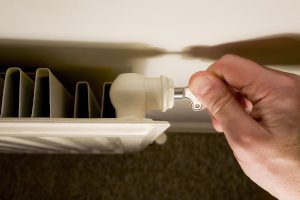 If your radiators are hot at the bottom but cold at the top, you have air trapped, which needs releasing for your combi boiler to work properly.
If your radiators are hot at the bottom but cold at the top, you have air trapped, which needs releasing for your combi boiler to work properly.
Combi boilers provide a combination of two functions: washing and heating. Your combi boiler channels water in two different routes, one for each function. Neither flow will come into contact with the other.
- Washing water: The cold water enters the boiler through an isolating valve and flows across the pressure switch paddle which tells the boiler to turn itself on. Next, the cold water enters the heat exchanger where it is heated, and then sent out to your taps.
- Central heating water: This water comes out of the top of the boiler, and either flows into the heating system or back to the heat exchanger. Next, the water flows down into the pump, through the heat exchanger and back out of the boiler into the return.
Combi boilers are ideal for home heating because they do not require a separate water tank and thus save a lot of space. They are also very efficient and can heat water very quickly as the need arises. So you never have to worry about having enough hot water when you want a shower.
Why you need to bleed your radiators
An important benefit of combi boilers is that they provide water to your taps and shower at the same pressure as your mains. This means you don’t need a hot water pump for a powerful shower. Your combi boiler provides enough water pressure on its own.
However, if you have air trapped in your radiators, it might cause your central heating system to be overpressurised.
Checking the pressure in your system
Look at the front of your combi boiler. You should see a gauge that shows how much pressure is in your system.
The ideal reading when your heating is off, and your taps and shower are not running, is about 1.5 bar (bars are units of pressure).
If your reading is much higher than 1.5 bar, it’s likely that you need to bleed some air out of your radiators to bring the pressure back down.
How to bleed your radiators
Bleeding your radiators is a relatively simple thing to do:
- Switch your heating off and wait until your radiators are cool.
- Locate the bleed valve at the top corner of the radiator.
- Find your radiator bleed key. If you don’t have one, you can buy one at a DIY store.
- Place a cloth under the bleed valve to catch any water.
- Holding the bleed key with a cloth, slowly turn it anti-clockwise to open your radiator’s valve. You will hear the air hissing as it escapes.
- Wait until the hissing stops and water starts to drip out.
- The air has now been released. Turn the bleed key clockwise to close the valve.
- Once all the radiators have been bled, you can turn your heating back on.
- Check the pressure gauge on the boiler to make sure it’s at the optimum level (around 1.5 bar).
- Check that your radiators are heating evenly and there are no leaks.
You may need to bleed some radiators more than once. If you’re still having problems, you should ask a professional engineer to inspect your heating system.
If you need help with bleeding your radiators or checking the pressure on your combi boiler, just give our Platinum Plumbers a call for a chat or to book an appointment. You can get hold of us on 020 8855 0361 or drop us a line at .

